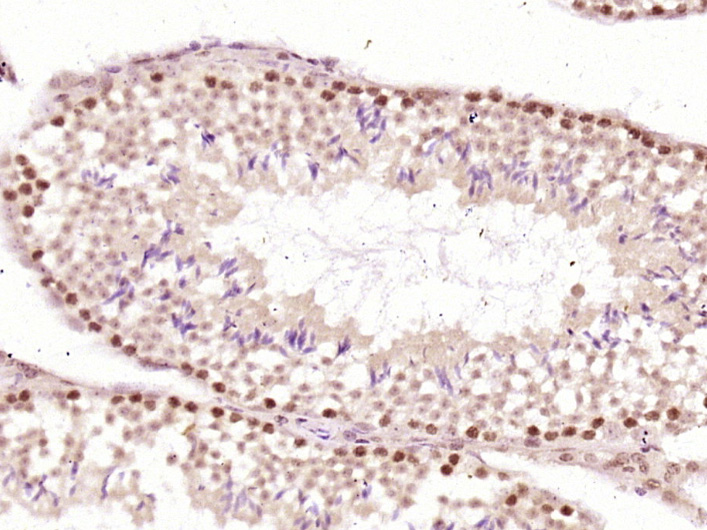
Rabbit Anti-Lpin1 protein antibody
EC=3.1.3.4; KIAA0188; LPIN1; PAP1; Phosphatidate phosphatase LPIN1; HDLCQ11; Lipase; LIPD; LIPOPROTEIN LIPASE; Lipoprotein lipase 1; LPL; MGC137861; MGC93586; LPIN1_MOUSE.
View History [Clear]
Details
Product Name Lpin1 protein Chinese Name Lpin1 抗体 Alias EC=3.1.3.4; KIAA0188; LPIN1; PAP1; Phosphatidate phosphatase LPIN1; HDLCQ11; Lipase; LIPD; LIPOPROTEIN LIPASE; Lipoprotein lipase 1; LPL; MGC137861; MGC93586; LPIN1_MOUSE. Research Area Cardiovascular Signal transduction Endocrinopathy Immunogen Species Rabbit Clonality Polyclonal React Species Mouse, (predicted: Rat, ) Applications ELISA=1:5000-10000 IHC-P=1:100-500 IHC-F=1:100-500 IF=1:100-500 (Paraffin sections need antigen repair)
not yet tested in other applications.
optimal dilutions/concentrations should be determined by the end user.Theoretical molecular weight 102kDa Cellular localization The nucleus cytoplasmic Form Liquid Concentration 1mg/ml immunogen KLH conjugated synthetic peptide derived from mouse Lpin 1 protein: 241-340/924 Lsotype IgG Purification affinity purified by Protein A Buffer Solution 0.01M TBS(pH7.4) with 1% BSA, 0.03% Proclin300 and 50% Glycerol. Storage Shipped at 4℃. Store at -20 °C for one year. Avoid repeated freeze/thaw cycles. Attention This product as supplied is intended for research use only, not for use in human, therapeutic or diagnostic applications. PubMed PubMed Product Detail Lipin 1 is a member of the Lipin family of nuclear proteins. This family contains three members: Lipin 1, Lipin 2 and Lipin 3, all of which contain a nuclear signal sequence, a highly conserved amino-terminal (NLIP) domain and a carboxy-terminal (CLIP) domain. LPIN1 (Lipin 1) is crucial for normal adipose tissue development and metabolism.
LPIN1 selectively activates a subset of PGC1 alpha target pathways, including fatty acid oxidation and mitochondrial oxidative phosphorylation by inducing expression of the nuclear receptor PPARalpha. LPIN1 also inactivates the lipogenic program and suppresses circulating lipid levels. An abundance of LPIN1 promotes fat accumulation and insulin sensitivity, whereas a deficiency in LPIN1 may deter normal adipose tissue development, resulting in insulin resistance and lipodystrophy, a heterogeneous group of disorders characterized by loss of body fat, fatty liver, hypertriglyceridemia and insulin resistance.
Function:
Plays important roles in controlling the metabolism of fatty acids at differents levels. Acts as a magnesium-dependent phosphatidate phosphatase enzyme which catalyzes the conversion of phosphatidic acid to diacylglycerol during triglyceride, phosphatidylcholine and phosphatidylethanolamine biosynthesis. Acts also as nuclear transcriptional coactivator for PPARGC1A/PPARA regulatory pathway to modulate lipid metabolism gene expression. Is involved in adipocyte differentiation. Isoform 1 is recruited at the mitochondrion outer membrane and is involved in mitochondrial fission by converting phosphatidic acid to diacylglycerol.
Subunit:
Interacts (via LXXIL motif) with PPARA. Interacts with PPARGC1A. Interaction with PPARA and PPARGC1A leads to the formation of a complex that modulates gene transcription. Interacts with MEF2C.
Subcellular Location:
soform 1: Mitochondrion outer membrane. Cytoplasm. Nucleus membrane. Note=Recruited at the mitochondrion outer membrane following phosphatidic acid formation mediated by PLD6. In neuronals cells, isoform 1 is exclusively cytoplasmic. In 3T3-L1 pre-adipocytes, it primarily located in the cytoplasm.
Isoform 2: Nucleus. Cytoplasm. Endoplasmic reticulum membrane. Note=Nuclear localization requires both CNEP1R1 and CTDNEP1. In neuronals cells, localized in both the cytoplasm and the nucleus. In 3T3-L1 pre-adipocytes, it is predominantly nuclear.
Tissue Specificity:
Specifically expressed in skeletal muscle. Also expressed prominently in adipose tissue, and testis. Lower expression also detected in kidney, lung, brain and liver. Isoform 1 is the predominant isoform in the liver. Isoform 2 is the major form in the brain.
Post-translational modifications:
Phosphorylated at multiple sites in response to insulin. Phosphorylation is controlled by the mTOR signaling pathway. Phosphorylation is decreased by epinephrine. Phosphorylation may not directly affect the catalytic activity but may regulate the localization. Dephosphorylated by the CTDNEP1-CNEP1R1 complex.
Sumoylation is important in brain and is marginal in other tissues. Sumoylation facilitates nuclear localization of isoform 2 in neuronals cells and its transcriptional coactivator activity.
DISEASE:
Note=Defects in Lpin1 are the cause of the fatty liver dystrophy phenotype (fld). Fld mutant mices are characterized by neonatal fatty liver and hypertriglyceridemia that resolve at weaning, and neuropathy affecting peripheral nerve in adulthood. Adipose tissue deficiency, glucose intolerance and increased susceptibility to atherosclerosis are associated with this mutation too. Two independent mutant alleles are characterized in this phenotype, fld and fld2j.
Similarity:
Belongs to the lipin family.
SWISS:
Q91ZP3
Gene ID:
14245
Database links:Entrez Gene: 23175 Human
Entrez Gene: 14245 Mouse
Omim: 605518 Human
SwissProt: Q14693 Human
SwissProt: Q91ZP3 Mouse
Unigene: 467740 Human
Unigene: 153625 Mouse
Lpin1 protein主要用于脂酯代谢异常、胰岛素抵抗及肥胖方面的研究。
该蛋白在肝,肺,肾,胎盘,脾脏,胸腺,淋巴结,前列腺,睾丸,小肠和大肠等组织中都有程度不同的表达。Product Picture
Bought notes(bought amounts latest0)
No one bought this product
User Comment(Total0User Comment Num)
- No comment



 +86 571 56623320
+86 571 56623320
 +86 18668110335
+86 18668110335

